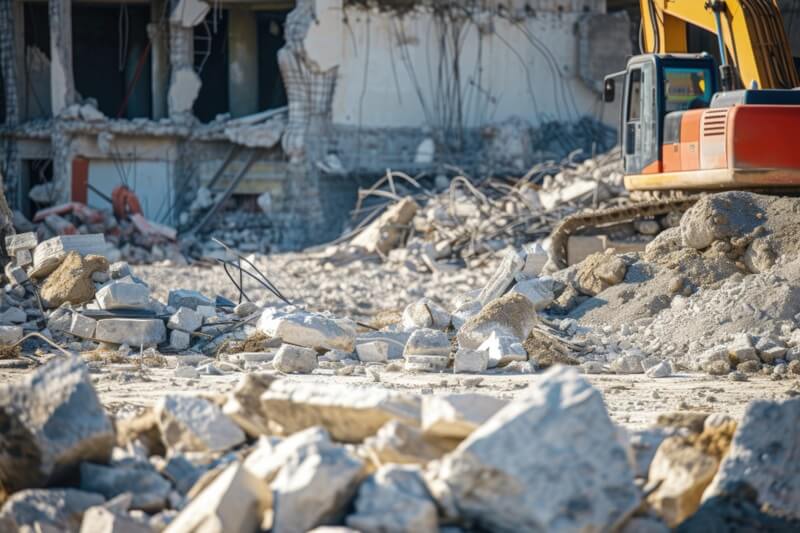Home demolition is essential for property owners looking to clear land for redevelopment, eliminate hazardous structures, or modernize their living spaces. While it may seem straightforward, home demolition involves careful planning, professional expertise, and strict adherence to safety and environmental regulations. This guide explores the key aspects of home demolition and what you need to know before starting your project.

Why Choose Home Demolition?
There are several reasons why homeowners may opt for demolition:
- Structural Damage: Properties weakened by age, weather, or natural disasters may need to be demolished for safety.
- Redesigning the Property: To build a new structure that aligns with modern needs and aesthetics.
- Property Value Enhancement: Clearing an outdated or hazardous home can increase land value.
- Compliance with Regulations: Homes not meeting current building codes may require demolition for legal compliance.
Types of Home Demolition
1. Full Demolition
This process involves tearing down the entire structure, leaving a clear site for new construction.
- Best for: Old homes, heavily damaged properties, or large-scale redevelopment projects.
2. Selective Demolition
Only specific parts of the home, such as walls, ceilings, or floors, are removed while retaining the rest of the structure.
- Best for: Renovations or partial rebuilds.
3. Mechanical Demolition
Heavy machinery like excavators and bulldozers are used to dismantle the structure efficiently.
- Best for: Large-scale projects requiring speed and precision.
4. Manual Demolition
Labor-intensive and slower, manual demolition is ideal for delicate jobs where certain materials must be salvaged.
- Best for: Historical properties or projects requiring careful dismantling.
Steps in the Home Demolition Process
1. Planning and Permits
Before starting demolition, secure the necessary permits from local authorities. This ensures compliance with zoning laws and safety regulations.
2. Asbestos and Hazardous Material Inspection
Old homes may contain asbestos, lead paint, or other hazardous materials. Professional inspection and removal are critical.
3. Disconnect Utilities
Water, gas, electricity, and sewage lines must be safely disconnected before demolition begins.
4. Salvaging Materials
Identify and salvage reusable materials like wood, bricks, fixtures, and appliances to reduce waste and save costs.
5. Demolition Execution
- For full demolition, heavy machinery is deployed to clear the site.
- Selective demolition requires precision and care to protect the remaining structure.
6. Site Cleanup
Debris is removed, and the site is prepared for new construction or landscaping.
Key Considerations for Home Demolition
1. Budget
Home demolition costs depend on factors like size, location, and the complexity of the project. It’s important to get multiple quotes from contractors to ensure cost-effectiveness.
2. Hiring Professionals
Choose licensed and experienced demolition contractors to ensure safety, efficiency, and adherence to regulations.
3. Environmental Responsibility
- Properly dispose of waste materials.
- Recycle or donate salvaged items whenever possible.
4. Safety Measures
Demolition is a high-risk activity that requires stringent safety protocols, including protective gear for workers and clear signage to keep bystanders away.
Benefits of Professional Home Demolition
- Efficiency: Professionals can complete the job quickly, minimizing downtime.
- Safety: Trained experts reduce the risk of accidents and property damage.
- Compliance: Licensed contractors ensure adherence to local laws and environmental standards.
- Cost Savings: Proper planning and execution can help avoid unexpected expenses.
Home Demolition Challenges
While home demolition offers many benefits, it also comes with challenges, including:
- Hidden Issues: Unforeseen obstacles like underground utilities or hidden hazardous materials can delay the process.
- Noise and Dust: Demolition can be disruptive to neighbors; proper mitigation measures are essential.
- Permit Delays: Obtaining the necessary approvals can sometimes take longer than expected.
Cost of Home Demolition
The cost of home demolition varies based on:
- Size of the Property: Larger homes require more labor and machinery.
- Demolition Type: Selective demolition is often more expensive than full demolition due to the labor-intensive nature.
- Location: Urban areas may have higher costs due to permit fees and logistical challenges.
Conclusion
Home demolition is a critical step in transforming properties to meet modern needs and safety standards. Whether you’re planning a full teardown or a selective remodel, working with experienced demolition contractors ensures a smooth and efficient process.
By understanding the steps, challenges, and benefits of home demolition, you can make informed decisions that align with your goals and budget. A well-executed demolition sets the foundation for creating the home of your dreams or maximizing the value of your property.
